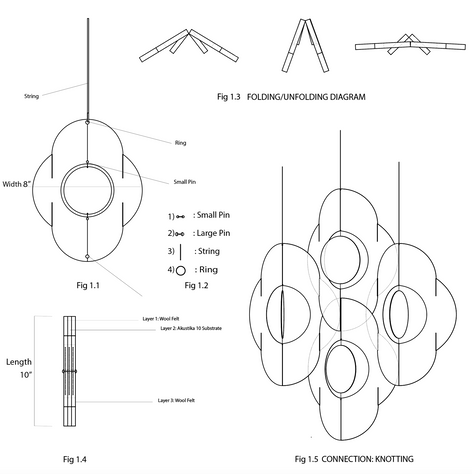
Alexander mATERIALITY &SPACE 3
California College of the Arts / Interior Design Department
Instructors: Margo Majewska & Margaux Schindler / Fall 2020
This sequential course in Materiality & Space focuses upon processes suggested by the distinct intention, application, and detailing of materials themselves. Through a series of projects, creative uses and innovative combination of methods, tectonics, research, performances, and synthesis are explored. I will study the quality of inhabitance, where the dimension of the interior affects the body’s senses, such as the sound of space, movement through space, and the materiality of space. The course also highlights the evolving breadth of sustainable “green” building design through methods of representation, life cycle of spatial systems, research, and issues of recycling. This puts into perspective, my role as a designer within the larger context of the global environment.

PATTERNS IN MEMORY
This image, which depicts two carps swimming around the coin, represents prosperity and luck. Its vivid colors and lovely imagery play a huge impact on my childhood memory as it is popularly used in painting, printing, and textile. During the New Year festival, people use the image a lot as the painting on the wall, or the lucky pocket, or on the dress.
For this project, I will be developing a design based on this image with the consideration of three factors, including: 1) Light; 2) Air; 3) Sound.
RECONSTRUCTION
//
DECONSTRUCTION OF MEMORY

2d models
In this series of iterations, I have explored different techniques and materials that are essential for the final model application. The process helped me to understand deeply the materiality and the effect that different materials can bring up. From bristol paper to foam and fabric, each material allows me to develop my design which would take consideration of materiality, light/air/sound effect, and structure.
Study of the structure


The waverly structure of cactus.


The knotting structure of orchids.
Study model of the final structure
The final structure is formed based on the previous study of the waverly structured cactus and the knotting structured orchids.


initial sketches
final rendering
Project: The Clovers
Designer: Alexander Wong
Description: Screens that can be folded or unfolded hanging by the ceiling.
Construction: 100% Wool Design Felt + Akustika 10 Substrate
Standard Sizes: 10” length, 8” width, 3” thickness.
Environmental: 100% Wool Design Felt is 100% biodegradable and Akustika 10 Substrate is 100% recyclable Contains no formaldehyde, 100% VOC free, no chemical irritants, and free of harmful substances 100% Wool Design Felt contributes to LEED.

Project: The Clovers Designer: Alexander Wong Description: Screens that can be folded or unfolded hanging by the ceiling. Within the design, each module has a moveable pinwheel that plays as open or close aperture allowing or blocking the light according to the wind/air circulation. Altogether, the design will create a dramatic magical visual effect under some air/lighting conditions.

Construction: 100% Wool Design Felt + Akustika 10 Substrate Standard Sizes: 10” length, 8” width, 3” thickness.

The Clovers by Alexander Wong

Project: The Clovers Designer: Alexander Wong Description: Screens that can be folded or unfolded hanging by the ceiling. Within the design, each module has a moveable pinwheel that plays as open or close aperture allowing or blocking the light according to the wind/air circulation. Altogether, the design will create a dramatic magical visual effect under some air/lighting conditions.





















